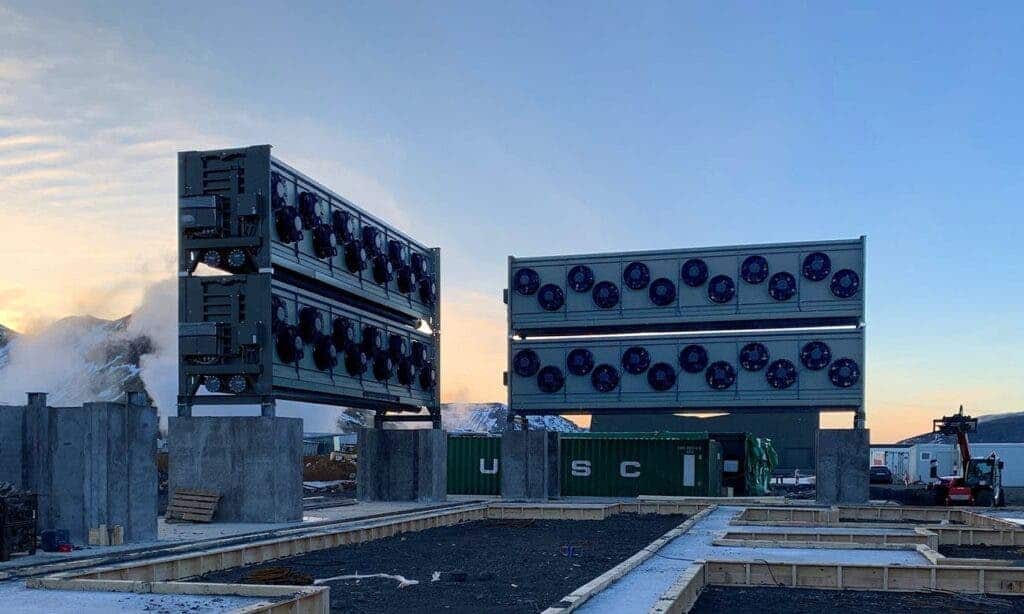A massive facility that can suck carbon dioxide out of the air and deposit it underground has officially begun operating in Iceland. This could be a big step forward for the technology, which has been suggested by climate experts as necessary to reduce greenhouse gases in a way to meet the targets of the Paris Agreement.

The plant is named Orca, after the Icelandic word “orka” which means energy. It was built jointly by the Swiss company Climeworks and the Icelandic company Carbfix, with a cost between $10 and $15 million. It will capture 4,000 tons of carbon dioxide sucked up from the air every year – which is equivalent to the greenhouse emissions from about 870 cars. That’s a drop in the bucket, but bear in mind this is still a pilot project, whose carbon absorption can be quickly scaled to meet growing demand.
It wasn’t randomly built in Iceland. The tiny island nation has the ideal underground geology to capture carbon and plenty of geothermal energy. Still, the costs are too high at the moment, at about $600 to $800 per metric ton of CO2. This is due to the energy requirements for the process and to the fact that it’s a fairly new piece of technology. The way all of it works, though, is intriguing.
Orca has four units, each made up of two metal boxes that are similar to the ones used in the shipping industry. Fans are built into the boxes, which capture CO2 out of the air through spongelike filters. These are blasted with heat, freeing the gas. Then the gas is mixed with water and pumped into underground caverns, where it turns into dark-gray stone.
But there are other ways of getting rid of the CO2. Farmers can use it for their plants, energy companies can mix it with hydrogen to make fuel, and soda manufacturers can use it to fizz their drinks. That’s why selling the captured CO2 could also be a way to lower the costs of the plant and to rely less on the current government subsidies.
“This is indeed an important step in the race to net-zero greenhouse gas emissions, which is necessary to manage the climate crisis,” Icelandic Prime Minister Katrin Jakobsdottir said at the opening ceremony. “This almost sounds like a science fiction story, but we do have other examples in our history of amazing advances in technology.”
Direct carbon capture
The technology used by Orca is known as direct carbon capture, one of the few ways to capture CO2 from the atmosphere. While scientists say it’s a necessary step in the fight against climate change, critics have argued that it’s still too expensive and that it could take decades to operate at scale. Still, the fact that Orca opened up is already a big first step.
At the moment, there are 15 direct carbon capture plants operating worldwide, mainly found in the US, Europe, and Canada, which cumulatively capture about 9,000 tons of CO2 per year, according to the International Energy Agency (IEA). A large-scale plant is currently being developed in the US that would have the capacity to pull one million tons per year of CO2 from the air.
Governments and business leaders are more focused on replacing fossil fuels with renewable energy rather than on exploring carbon capture. While it’s true that renewables are getting cheaper energy day, there’s a big part of our emissions that come from other industrial activities that are very hard to decarbonize, such as cement factories.
This is where carbon capture can come in and make a difference. The Intergovernmental Panel on Climate Change (IPCC), a leading group of climate experts, has repeatedly mentioned the use of the technology as necessary to mitigate our emissions, as well as the IEA in its reports. More and more, researchers are considering it as a necessary technology ahead.
A study by Imperial College London said last year that no more than 2,700 gigatons (Gt) of CO2 would have to be captured to meet the most aggressive climate targets. The researchers also argued that the current rate of growth in the installed capacity of CCS is not on track to meet those targets, but asked to maintain the research and commercial efforts in place.


